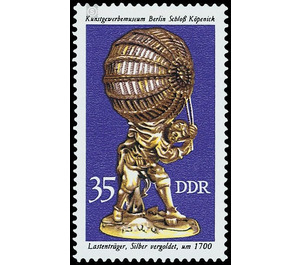Historical arts and crafts - Germany / German Democratic Republic 1976 - 35 Pfennig
Theme: Economy & Industry
| Country | Germany / German Democratic Republic |
| Issue Date | 1976 |
| Face Value | 35.00 |
| Color | violet |
| Perforation | K 14 |
| Printing Type | Rotogravure 2 |
| Stamp Type | Postage stamp |
| Item Type | Stamp |
| Chronological Issue Number | 1916 |
| Chronological Chapter | GER-DDR |
| SID | 54070 |
| In 15 Wishlists | |
Historic Arts and Crafts The Ministry of Posts and Telecommunications of the German Democratic Republic publishes five multi-colored special postage stamps depicting exhibits from the Kunstgewerbemuseum Berlin in the Köpenick Castle. Historic Arts and Crafts of the Kunstgewerbemuseum Berlin, Köpenick Castle The Berlin Kunstgewerbemuseum in the Baroque Köpenick Palace, founded in 1867 as the first German museum of its kind, preserves in its collections outstanding examples of European craftsmanship from the Middle Ages to the present. Under the historical term "handicraft" all those commodities are summarized, which go beyond their pure purpose form, through figurative or ornamental decor, an artistic design. It is not decisive whether the object designed in this way can still be used in the sense of everyday use, or whether it served only the aesthetic edification of the individual, the artistic enrichment of the living space or the representation of the social position of its owner and thus the rank of Artwork is collected. Creative imagination, extraordinary creative power and perfect mastery of the craftsmanship techniques and materials were and are the prerequisites for the creative work in the field of applied arts. For a series of 400 years, each of these characteristic, artistically and artisitcally outstanding objects was selected for the present series "Historical Handcrafts", each of which, in its form, decoration and material, is capable of reflecting the defining artistic trend of a period of style as representative of many other things. In addition to porcelain, at the time of the Baroque and Rococo periods, works of silver and gold in particular were among the precious table decorations of feudal society. Such a masterpiece of silver driving art is represented by the 35-pfennig-value load carrier of the Augsburg goldsmith Daniel Männlich, who, in his expressive design of the human body, makes the close connection between art and handicraft very clear.


